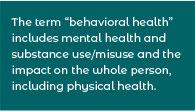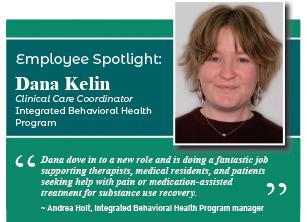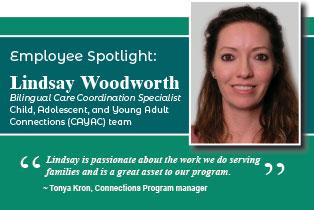Tackling behavioral health needs
by Julie Estlick
 When the Health District conducted its first Community Health Survey in 1995, 1 in 5 residents said they or a household member needed mental health services. Yet a third of those people could not afford care, and another third didn’t know where to turn for help. As a result, Mental Health Connections became the second service offered by the Health District, ushering in an era when the agency would play a key role in expanding behavioral health services in the community, both through its own programs, as well as through partnerships with other organizations.
When the Health District conducted its first Community Health Survey in 1995, 1 in 5 residents said they or a household member needed mental health services. Yet a third of those people could not afford care, and another third didn’t know where to turn for help. As a result, Mental Health Connections became the second service offered by the Health District, ushering in an era when the agency would play a key role in expanding behavioral health services in the community, both through its own programs, as well as through partnerships with other organizations.
A decade later, the Health District was one of the first organizations to place behavioral health specialists in health-care clinics serving the uninsured or those with low incomes, so that patients could receive immediate attention or schedule an appointment right at their doctor’s office.
| Integrated Behavioral Health Program |
|---|
|
Last year, the Integrated Behavioral Health team served 1,161 patients. Services are available only to current patients at FMC and Salud. |
| Mental Health and Substance Use Connections |
|---|
|
Launched in 1996, Mental Health Connections had two components. The first was a network of local behavioral health providers who would see clients with low income and no insurance. Health District staff provided the connection to a therapist based on the clients’ counseling needs. The program also provided a referral service by phone and a searchable online database that was unusual for its time. In 2017, Mental Health Connections expanded its services beyond adults with the debut of the Child, Adolescent, and Young Adult Connections (CAYAC) team that focuses on the early identification and treatment of youth with behavioral health needs, with support for both client and family. Adult Connections teamToday, there continues to be a strong need for behavioral health treatment and support in our community. Last year, the Adult Connections team served 2,864 clients ages 18 and up, providing appropriate referrals and care coordination for ongoing behavioral health services in the community and brief psychotherapy. For more information or to make an appointment, call Connections at 970-221-5551. Bilingual staff members are available.
|
| Community Dual Disorder Treatment Program |
|---|
|
In the early 2000s, community behavioral health leaders recognized that individuals living with both severe mental health and substance use disorders (called co-occurring disorders) required unique interventions and community-wide support to have better treatment outcomes and quality of life. The Community Dual Disorder Treatment (CDDT) Program was born in 2008 with staff from the Health District and SummitStone Health Partners providing combined substance use and mental health services, usually at a client’s home. In conjunction with SummitStone Health Partners staff, a psychiatrist and nurse team from the Health District meet clients for weekly check-ins. They do assessments that include monitoring of psychiatric symptoms, response to medications, medication administration, discussion and monitoring of substance use, and blood pressure and blood sugar checks. Thanks to these supports and receiving ongoing behavioral health services, CDDT participants are much less likely to be routine users of hospital emergency departments or to regularly interact with law enforcement. |
 Health-care providers are often the first to learn of their patients’ mental health or substance use challenges. This is especially true when the patients are uninsured or come from lower-income households and face numerous health and economic hardships. In 2005, after hearing from providers at local “safety net” clinics that there was a major need for help in addressing their patients’ behavioral health concerns, the Health District established its Integrated Behavioral Health Program. Behavioral health specialists, including a psychiatrist, are placed at Salud Family Health Center and UCHealth’s Family Medicine Center (FMC). There they work alongside health-care providers delivering care and, at FMC, participate in the training of family medicine residents.
Health-care providers are often the first to learn of their patients’ mental health or substance use challenges. This is especially true when the patients are uninsured or come from lower-income households and face numerous health and economic hardships. In 2005, after hearing from providers at local “safety net” clinics that there was a major need for help in addressing their patients’ behavioral health concerns, the Health District established its Integrated Behavioral Health Program. Behavioral health specialists, including a psychiatrist, are placed at Salud Family Health Center and UCHealth’s Family Medicine Center (FMC). There they work alongside health-care providers delivering care and, at FMC, participate in the training of family medicine residents. CAYAC team
CAYAC team